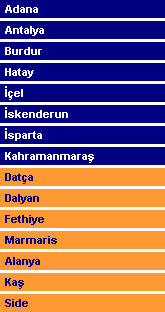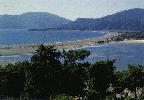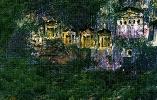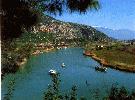| Dalyan... |
|
About 70 km east of Marmaris, at a place called Yuvarlak Cay, signs point south (right) to "The Graves of Likya" and
"The Ruins of Caunos", nine km down a side road. Coming by bus, get out at Ortaca and catch a dolmus to Dalyan. The
road brings you to the settlement - a small farming and fishing town with a sideline in tourism - through lush cotton
and vegetable fields, along the winding course of a stream, the Dalyan Cayi. On the town's tidy quay you can choose an
excursion boat for a cruise to the ruins of Caunos, the pretty cove at Ekincik, the beach at Iztuzu on the Mediterranean
coast or up the Dalyan Cayi stream to Koycegiz Lake. A two-hour tour just to the Caunos ruins costs US $ 12 to US $ 18
for the entire boat; if you want to visit the Sultaniye hot springs as well, figure on three hours and US $ 25 for the
boat. If you would also like to go to Iztuzu beach for a swim, it'll take four to five hours and cost US $ 36 for the
boat. Do some haggling to get the best price, particularly if there are many boats without work. The river excursion
boats can carry about 12 people. Boats belonging to the "Dalyan Kooperatifi" operate a river "dolmus" service between
the town and Iztuzu beach, charging US $ 1 for the round trip. In high summer there may be five or more boats per day,
heading our from 9 to 11 am, returning between 4 and 6 pm. Take some food as you might not like the few little kebap
stands on the beach, which has a few other facilities. The beach, by the way, is renowned as a nesting - place for sea
turtles - an endangered species, Caretta Caretta. There are three ways of reaching Caunos which attract great
attention today owing to its Venetian type of channel and Lycian type of tombs. The visitors who come by means of their
yachts, land on the island named Delikli Ada and reach the site of the ruins by starting off in small boats from here;
those who come from Marmaris by sea route, drop anchor in the vicinity of Delikli Ada and also reach the site of the
ruins in small boats; and those who come by land route, reach the ruins by starting boats from the Village of Dalyan
which is at a distance of 27 km from Köycegiz. The existance of the ruins of Caunos was first discovered in the year
1842, and excavations have been carried on there by the Turkish archaeologists under the supervision of Prof. Baki
Ögün since 1967. Caunos, the son of Miletos, had been indicated as the founder of the city and therefore, it had been
named Caunos.
|
|

|






 For a lovely holiday... Click here !!!
For a lovely holiday... Click here !!!


